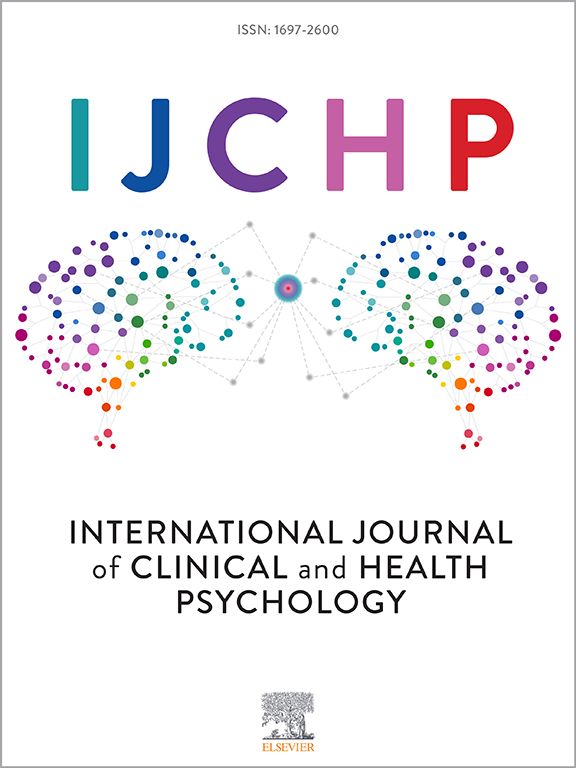执行功能调节条件恐惧的消退和恢复:转移、更新和抑制的不同作用
IF 4.4
1区 心理学
Q1 PSYCHOLOGY, CLINICAL
International Journal of Clinical and Health Psychology
Pub Date : 2025-04-01
DOI:10.1016/j.ijchp.2025.100581
引用次数: 0
摘要
条件恐惧学习对生存至关重要,恐惧消退失败与焦虑障碍的发展密切相关。本研究探讨了不同的执行功能(EF)子组件-转移、更新和抑制-如何在行为和神经水平上调节条件性恐惧的消退和恢复。共有88名参与者(年龄范围:17-23岁)完成了Stroop任务、数字大小奇位转换任务和记忆更新任务,以评估他们的执行功能能力。参与者接受经典的恐惧消退范式,同时使用功能近红外光谱(fNIRS)记录他们的休克预期评分和前额皮质活动。结果表明,转移能力高的个体在恐惧习得期(β = -0.406, p = 0.032)和恢复期(β = -0.834, p = 0.004)表现出更高的恐惧预期,前额叶皮层活动也较高(p <;0.05),表明对威胁刺激的反应增强。更新能力高的个体在消退阶段的恐惧预期下降较慢(β = 0.038, p = 0.002),但在消退回忆阶段的恐惧预期下降较慢(β = -0.769, p = 0.006),表明消退学习较差,消退记忆保持较好。更新能力高的个体在前额叶皮层区域也表现出更多的灭绝记忆(ps <;0.045)。抑制能力高的个体在消失学习过程中对CS+的期望较高,对CS -的期望较低(β = -0.409, p = 0.008),对恐惧的期望降低较慢(β = -0.022, p = 0.055)。此外,抑制能力高的个体在立即消失时PFC活性较低(ps <;0.0421),这表明消退学习较慢,但对安全线索的调节较好。通过澄清这些执行功能成分的作用,我们的研究强调了认知机制,可以为旨在改善恐惧消除的干预提供信息,为减轻焦虑相关障碍提供潜在的策略。本文章由计算机程序翻译,如有差异,请以英文原文为准。
Executive functions modulate conditioned fear extinction and reinstatement: The differential roles of shifting, updating, and inhibition
Conditioned fear learning is crucial for survival, and failure of fear extinction is closely related to the development of anxiety disorders. This study explores how different executive function (EF) subcomponents—shifting, updating, and inhibition—modulate conditioned fear extinction and reinstatement at both behavioral and neural levels. A total of 88 participants (age range: 17–23 years) completed the Stroop Task, Digit Size-Parity Switching Task, and Memory Updating Task to assess their executive function abilities. Participants underwent a classical fear extinction paradigm while their shock expectancy ratings and prefrontal cortical activity were recorded using functional near-infrared spectroscopy (fNIRS). Results indicated that individuals with higher shifting ability exhibited greater fear expectancy during fear acquisition (β = -0.406, p = 0.032) and reinstatement (β = -0.834, p = 0.004), along with higher prefrontal cortex activity (p < 0.05), suggesting heightened responses to threatening stimuli. Individuals with higher updating ability showed a slower decrease in fear expectancy during the early extinction phase (β = 0.038, p = 0.002), but maintained lower expectancy during the extinction recall phase (β = -0.769, p = 0.006), indicating poorer extinction learning but better extinction memory retention. Individuals with higher updating ability also exhibited more extinction recall in the prefrontal cortex regions (ps < 0.045). Individuals with higher inhibitory ability showed higher expectancy for CS+ and lower expectancy for CS− during extinction learning (β = -0.409, p = 0.008), along with a slower decrease in fear expectancy (β = -0.022, p = 0.055). Furthermore, individuals with higher inhibition ability showed lower PFC activity in immediate extinction (ps < 0.0421), suggesting slower extinction learning but better regulation of safety cues. By clarifying the roles of these executive function components, our study highlights the cognitive mechanisms that could inform interventions aimed at improving fear extinction, offering potential strategies for mitigating anxiety-related disorders.
求助全文
通过发布文献求助,成功后即可免费获取论文全文。
去求助
来源期刊

International Journal of Clinical and Health Psychology
PSYCHOLOGY, CLINICAL-
CiteScore
10.70
自引率
5.70%
发文量
38
审稿时长
33 days
期刊介绍:
The International Journal of Clinical and Health Psychology is dedicated to publishing manuscripts with a strong emphasis on both basic and applied research, encompassing experimental, clinical, and theoretical contributions that advance the fields of Clinical and Health Psychology. With a focus on four core domains—clinical psychology and psychotherapy, psychopathology, health psychology, and clinical neurosciences—the IJCHP seeks to provide a comprehensive platform for scholarly discourse and innovation. The journal accepts Original Articles (empirical studies) and Review Articles. Manuscripts submitted to IJCHP should be original and not previously published or under consideration elsewhere. All signing authors must unanimously agree on the submitted version of the manuscript. By submitting their work, authors agree to transfer their copyrights to the Journal for the duration of the editorial process.
 求助内容:
求助内容: 应助结果提醒方式:
应助结果提醒方式:


